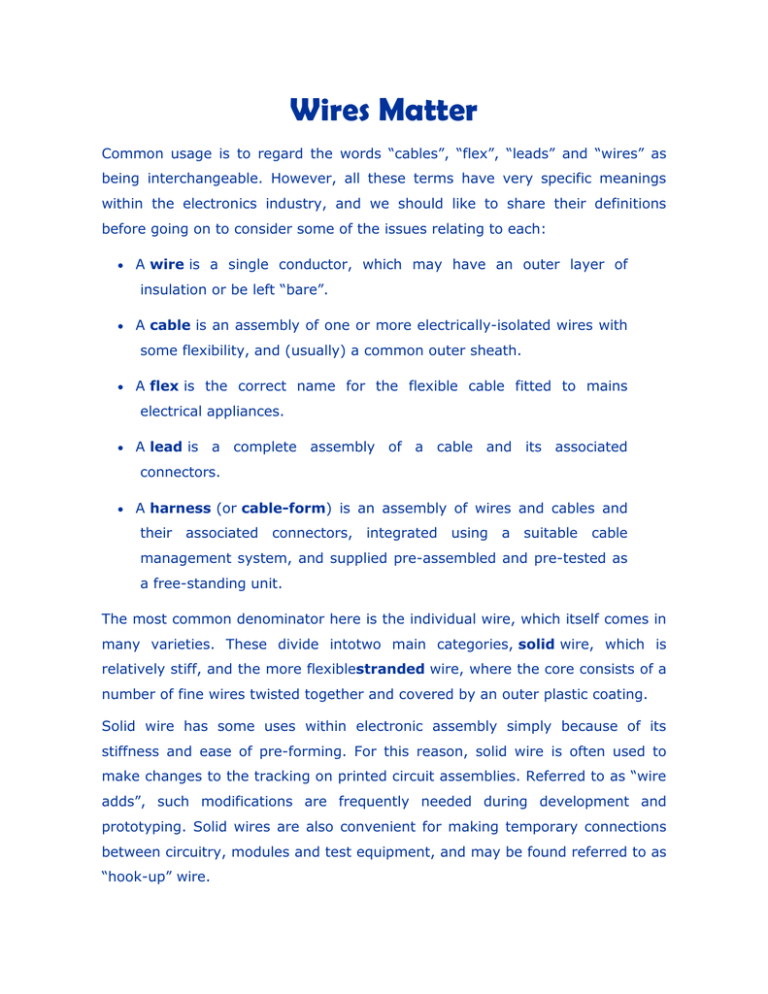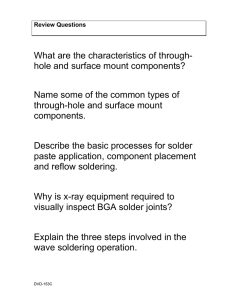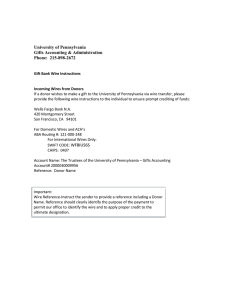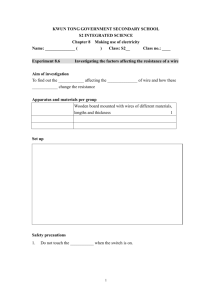Wires Matter
advertisement

Wires Matter Common usage is to regard the words “cables”, “flex”, “leads” and “wires” as being interchangeable. However, all these terms have very specific meanings within the electronics industry, and we should like to share their definitions before going on to consider some of the issues relating to each: • A wire is a single conductor, which may have an outer layer of insulation or be left “bare”. • A cable is an assembly of one or more electrically-isolated wires with some flexibility, and (usually) a common outer sheath. • A flex is the correct name for the flexible cable fitted to mains electrical appliances. • A lead is a complete assembly of a cable and its associated connectors. • A harness (or cable-form) is an assembly of wires and cables and their associated connectors, integrated using a suitable cable management system, and supplied pre-assembled and pre-tested as a free-standing unit. The most common denominator here is the individual wire, which itself comes in many varieties. These divide intotwo main categories, solid wire, which is relatively stiff, and the more flexiblestranded wire, where the core consists of a number of fine wires twisted together and covered by an outer plastic coating. Solid wire has some uses within electronic assembly simply because of its stiffness and ease of pre-forming. For this reason, solid wire is often used to make changes to the tracking on printed circuit assemblies. Referred to as “wire adds”, such modifications are frequently needed during development and prototyping. Solid wires are also convenient for making temporary connections between circuitry, modules and test equipment, and may be found referred to as “hook-up” wire. For most applications, however, stranded wire is more appropriate. Made of many fine strands, it can withstand repeated bending without breaking, and is therefore appropriate for connections that may be disturbed, such as external wiring. For wiring subjected to continual movement, such as test leads, the “extra-flex” version is a better choice. A wire is usually specified by the number of strands and the diameter of each strand, though some types will indicate the total effective cross-sectional area of the conductors. For example, an equipment wire described as “7/0·2” has 7 strands of 0.2mm diameter copper wire. The individual strands are laid together, but occupy a slightly greater cross-sectional area than solid wire with the same area and current rating. So our 7/0.2 equipment wire, which has a central core diameter of 0.6mm, has an overall cross-sectional area and current rating that are actually 22% less than the equivalent “1/0.6” solid wire. Whether solid or stranded, the conductor within most wires is made of extruded copper on the grounds of its conductivity. The extrusion process work-hardens the copper, so that wires are stiffer than the billet from which they are made. As with most copper for electrical use, an OFHC grade is used, the acronym standing for Oxygen-Free High Conductivity. Thicker wires, especially those provided bare, may also be supplied annealed, their comparative softness being advantageous for tasks such as winding. Where long lengths of wire are hung unsupported, there is a danger with a copper wire that the stress applied may lead to yield and fracture, so some cables for external use may be strengthened by the inclusion in the multiple strand of one or more steel wires. An alternative is to provide such strengthening as part of an overall “armouring”. Particularly for power applications, some use has been made of aluminium wire, but this is subject to corrosion attack, and is difficult to terminate. Even a copper wire will oxidise in an air environment, so many higher-quality wires will have some protective coating, which is often plated tin. For low frequency purposes, additional current-carrying capacity is provided by using more strands, or thicker strands. However, at high frequencies, the “skin effect” sets a limit to the effectiveness of merely increasing the strand diameter. A solution is to use fine strands of wire that are insulated from each other with a thin coating. However, if we merely run wires parallel to each other, we can run into problems with electrical noise and inductance and capacitance losses. The solution is what is referred to as Litz wire, which is made from a bunch of twisted wires, carefully configured so that each wire is only close to a given neighbour for the smallest possible length. Using this type of wire almost compensates for skin-effect problems, and significantly reduces eddy current losses. Regardless of the form of the core, most wires will be provided with a thin coating of insulation. The material most commonly used is PVC, which is cheap, easy to work, easy to colour, and easy to strip. A downside is its maximum temperature rating which is typically only 70°C. Bear in mind that wires have resistance, and will self-heat if passing significant current! The local temperature may also be increased because of dissipation in adjacent conductors – this is the reason why a conventional extension lead has two current ratings, one for the fully-wound condition, and a significantly higher rating when the lead is fully extended. This temperature limitation for standard PVC means that many applications require enhanced materials, PTFE being a common choice for high temperature applications. For some applications, a single layer of insulation is not sufficient, and extra layers may be built up, for example providing a braided outer layer to enhance abrasion resistance. In other cases, the requirement is that the primary insulation should have specific electrical characteristics. For example, noise screening may be provided by using a primary layer that is made slightly conductive by the addition of carbon; some RF conductors may need insulation made of materials such as polythene that have a low dielectric constant. From the manufacturing perspective, all these alternative constructions are more difficult to handle, and especially to strip without doing damage to the internal core. Once we consider cables, assemblies of wires, rather than individual wires, the range of options extends considerably, especially in relation to physical protection and providing earthing and screening. Even at relatively low frequencies, such as those used by telephones, it is not uncommon for “pairs” within a multi-pair cable to be twisted together, to reduce cross-talk; once we come to radio frequencies, we may need to provide known-impedance connections, using either a twin wire and screen or a co-axial construction. Especially with co-axial cables, there are many variants, depending on frequency and power handling capability, and these are way beyond this module. Bear in mind that, as with all high frequency connections, the need to maintain a constant impedance, and avoid losses, especially with connectors. A challenge with any multi-core assembly even at low frequency, is uniquely identifying which conductor is which! Which is why even something as simple as a mains cable, with just three connections, will be clearly colour coded. For data connection, much use is made of the physical arrangement of the individual conductors in a ribbon cable, where the only requirement is to have a polarity indicator; for circular multi-core cables, the usual solution is to use different insulation colours – by using coloured stripes as well as body colour, it is possible to uniquely identify many different conductors using a relatively restricted colour pallet. Particularly with high temperature insulation, it may be difficult to provide unique wire identity other than by numbering individual wires using some kind of wire marker. For larger wires, these may be self adhesive types; for smaller wires, individual cable markers may be needed. Bear in mind that applying individual numbered or coloured sleeves to fine wires is a time-intensive activity! Source : http://www.ami.ac.uk/courses/topics/0256_wm/ index.html


